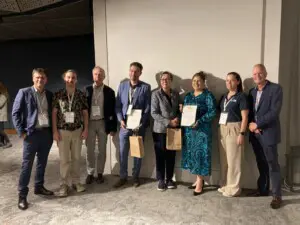Tell us about your work.
My research focuses on quantifying transport processes (water and solute fluxes) in soil-plant-atmosphere systems. The work conducted under the CRC TiME project represents a ground-breaking study that links climate change predictions, soil hydrological performance, and drought indices with plant performance during the mine rehabilitation process in the Latrobe Valley.
The controlled experiment was designed with two different cover depths and vegetation on top of the coal layer. High-resolution sensors were installed in the columns to measure soil water dynamics and temperature changes. To simulate real conditions, undisturbed coal materials with intact porous systems were used. This, combined with advanced hydrological numerical modelling (dual porosity), led to an innovative approach.
Experimental results indicated that the drying period prompted plants to develop deeper root systems capable of accessing water accumulated above the coal layer. The impact of deeper soil cover was evident in the total soil water storage, significantly influenced by the potential presence of fractures. The fracture patterns in coal, which are challenging to assess, play a critical role in the water balance and warrant further in-depth research.
What does the term ‘research communication’ mean to you?
To me, research communication involves effectively sharing and disseminating research findings to a broader audience.
This can be particularly challenging with highly specific research outcomes derived from complex methodologies.
There are various ways to address this, including writing and publishing in scientific journals, presenting results at various events (seminars and conferences), engaging with peers and the public through social media and interviews, and translating complex findings from technical/scientific language into plain language.
Tell us about the research communication activities you undertook to explain and share complex information about soil hydrology.
Essentially, all of the aforementioned activities were undertaken to communicate our research findings.
The findings were presented at domestic and international conferences in the fields of soil science (SSA), geosciences (EGU), and environmental modelling (MODSIM). These activities led to an invitation to deliver a keynote lecture at Northwest A&F University in China and an invitation to do an interview with the CRC TiME Dig Deeper webinar series.
Currently, a draft version of the manuscript is prepared and will be submitted soon to a scientific journal. LinkedIn was used as a platform to communicate different stages of our research.
What feedback did you receive from end users?
The feedback was overwhelmingly positive and varied depending on the end user group. Researchers were interested in the details of the study and potential collaborations or the application of experimental or modelling components to other problems. The mining industry raised questions about practical implementation and how some of the findings could be used to design soil covers more efficiently. Additionally, the communication resulted in multiple enquiries and potential collaboration opportunities.
What advice would you give to other researchers looking to communicate their findings?
Tailor your communication to your audience and disseminate your research findings through multiple channels. It may sound straightforward, but it can be quite a challenging task!


